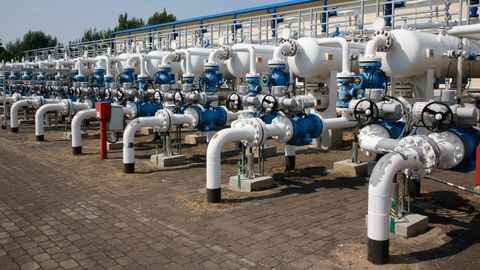The loss of inexpensive Russian gas supplies caused Europe’s economy to stall significantly, inflation to rise, and the cost of living problem to intensify.
On New Year’s Day, Russian gas shipments to Europe through Ukraine will come to an end, ending Moscow’s lengthy reign of supply domination in the European gas market.
As a five-year transit agreement between Russia and Ukraine comes to an end, Russia’s oldest gas export route to Europe—a pipeline that dates back to the Soviet era—was scheduled to close by the end of 2024. Russia has not asked for any gas flows for January 1, according to data released Tuesday by Ukraine’s gas transit operator.
Following the start of the conflict in Ukraine in February 2022, the European Union looked for alternate gas suppliers and significantly decreased its reliance on Russian gas.
The other Russian gas consumers, including Slovakia and Austria, have made arrangements for substitute supply, and analysts predict that the halt will have little effect on the market.
Although stopping the gas flow will have far greater geopolitical ramifications, Moscow has lost its hegemony over gas supplies to EU nations to competitors like the US, Qatar, and Norway since the war in Ukraine, which forced the EU to reduce its reliance on Russian gas.
State-owned Gazprom, once the largest gas exporter in the world, lost $7 billion in 2023 alone—its first yearly loss since 1999.
The loss of inexpensive Russian gas supplies caused Europe’s economy to stall significantly, inflation to rise, and the cost of living problem to intensify.
The loss of Russian gas has intensified long-term worries about Europe’s waning global competitiveness, particularly over Germany’s industrial future, even if the continent has been quick to locate new energy sources.
The conflict in Ukraine has virtually devastated Gazprom’s business, despite the fact that Russia and the Soviet Union spent fifty years gaining a significant portion of the European gas market, which at its height was about thirty-five percent.
The majority of Russian gas routes to Europe are closed, including the 2022-bombed Nord Stream beneath the Baltic and Yamal-Europe via Belarus.
Gas from Siberia is transported by the Soviet-era pipeline across Ukraine, passing through the town of Sudzha, which is now occupied by Ukrainian troops, in the Kursk region of Russia. After passing through Ukraine, the pipeline enters Slovakia, where it divides into branches that travel to Austria and the Czech Republic.
Negotiations for a new transit agreement have been rejected by Kiev.
Other routes
Gazprom will lose about $5 billion in gas deliveries to Europe through Ukraine, while Ukraine forfeits about $800 million in annual levies from Russia.
Given the tiny volumes of gas left, it seems doubtful that the transit deal’s termination will result in a recurrence of the EU gas price surge of 2022.
In 2023, Russia exported over 15 billion cubic meters of gas through Ukraine, which accounted for barely 8% of the country’s peak gas flows to Europe through other routes in 2018 and 2019.
In contrast to Monday, when it sent 42.4 million cubic meters, Gazprom reported sending 37.2 million cubic meters on Tuesday.
Later, as of 1500 GMT, Russia had not designated any gas flows for January 1 through the Ukrainian pipeline to Europe, according to Ukraine’s gas transit operator.
Moldova, a former Soviet member, will suffer a serious setback as a result of the suspension of supplies through Ukraine.
Despite Hungary’s desire to maintain the Ukrainian route, Russian gas is still delivered to Hungary and other nations from the south via the TurkStream pipeline on the Black Sea’s bed.






